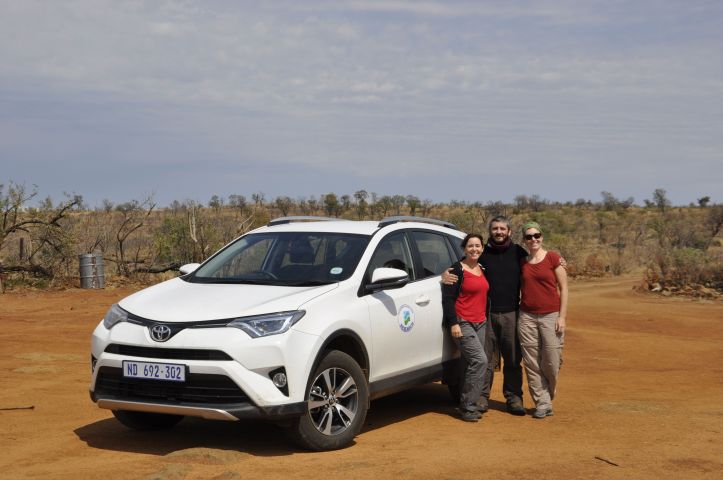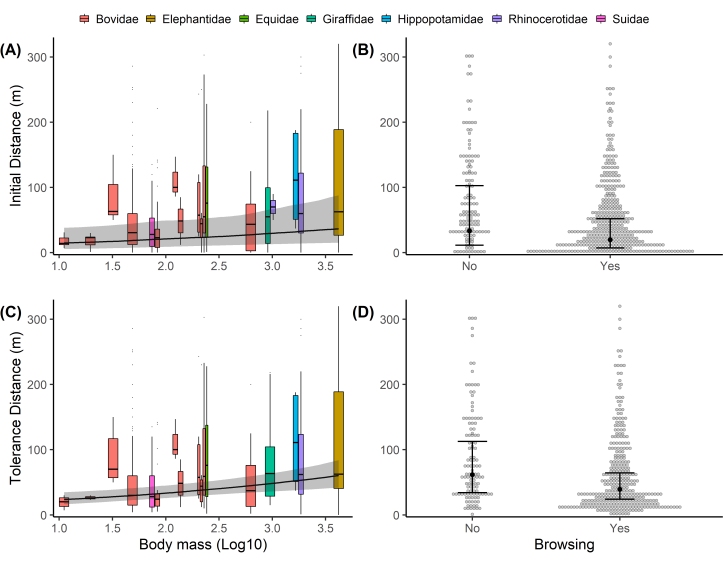 Nearly four years ago “el equipo MA” (Mara Mulero, Marcello D’Amico and I, Manuela) travel to South Africa to explore how ungulates – hoofed mammals, respond to roads and traffic within Protected Areas (following up from a previous collaboration). We visited three different parks driving within their road network to find ungulates. When we found any, we noted the species, position (distance from the road and our vehicle) and behaviour. Particularly we were interested in flight responses, when animals become alarm and flee from a perceived danger, our vehicle in this case.
Nearly four years ago “el equipo MA” (Mara Mulero, Marcello D’Amico and I, Manuela) travel to South Africa to explore how ungulates – hoofed mammals, respond to roads and traffic within Protected Areas (following up from a previous collaboration). We visited three different parks driving within their road network to find ungulates. When we found any, we noted the species, position (distance from the road and our vehicle) and behaviour. Particularly we were interested in flight responses, when animals become alarm and flee from a perceived danger, our vehicle in this case.

We drove on both paved and dirt roads, all of which were open to tourists, and we measured the traffic we encountered.
After hundreds of kilometres driven we ended up with 513 sightings representing 18 different ungulate species that included diverse species from elephants to impalas and quite a few white rhinos (after Hluhluwe-iMfolozi Park, HiP, we called them “aburrinos” because we saw so many! if you speak Spanish you get the joke, if not aburrido is boring in Spanish, and rino is well, rhino; yes, we are a funny bunch).
Once the fieldwork fun was over we each returned to our research institutions. At the University of Reading, where I work, Daniela Duffett joined the EcCo lab to complete her MSc project which was just published in Ecological Indicators.
She patiently entered the data we had collected, and then completed analyses that explored two main questions:
Are species with particular traits more likely to stay away from roads?
We used trait-based models which are regression models that use information on characteristics of different organisms to predict an outcome or response. For this study the response was how far animals were in relationship to the road. In the past, I have used these models to predict how likely animals are to become roadkill, to have increased risk of extinction, or become invasive species. These models can also include other factors that may be important or one wishes to control for, in our case we considered the type of habitat, the traffic, the type of road and the date for each observation.
We proposed two types of hypotheses a priori. First, we hypothesized some traits could influence the perception of roads as danger and affect spatial distribution. For example, smaller species have increased predation risk and are more likely to avoid perceived dangers than larger ones. Second, we expected some traits could be associated with our ability to see the animals (their detectability); for example, it is easier to see a white rhino that weights 1800 kg than a grey duiker with its less than 20 kg. Close to the road we should see both, but further away smaller ungulates may be more easily missed.
We found support for the detectability hypotheses, with smaller animals with browsing foraging habits (more likely to be found in forest or vegetated areas where it is more difficult to see them) were less likely to be sighted far from roads.

Apparently, traits may not be particularly useful to tell us about which ungulates avoid proximity to roads (although I think we need more evidence, more data, more African trips! to make sure that is the case). But how about our second question?
Can we use traits to predict flight responses?
Using the same trait-based modelling approach we tested whether we could use trait data to predict the probability of an animal fleeing when we stopped our vehicle. As before we had both biological and methodological hypothesis. And this time we found support for biological effects (the interesting ones), which propose animals can perceive vehicles as danger, as predators, and will be more likely to respond the more vulnerable to predation they are.
So turns out, smaller, solitary species that are non-grazers are more likely to run away in the presence of a vehicle. This makes sense, smaller species are more vulnerable to predation; solitary animals have to be more cautious (less eyes to keep watch and no dilution effect); and grazers are in more open landscapes were predators can be detected earlier, so non-grazers may be “jumpier”.

Traits as predictors of road and traffic impacts
There are millions of kilometres of roads in the world, with more and more being built (although COVID-19 may change some things…). Some of these roads are found in protected areas, and are important because they provide access to tourists who provide needed income to support these areas and the nearby communities (best case scenario, sometimes it does not quite work).
It is important we understand how roads affect wildlife, but studying individual species and parks is time-consuming and expensive (still also fun!). Our work opens a door for initial assessment. Based on the ungulate fauna present in one area we could predict which ones may be more vulnerable, more affected by vehicles. We could then think about road development that avoids their preferred areas or regulate traffic to avoid stressing them. We could also use the assessment to prioritize studies and monitoring of those species that we predict may be most impacted.
Predictive modelling cannot replace field work and data collection, but it can provide a helping hand.
Read the full study: Duffett, D; D’Amico, M; Mulero-Pázmány, M; González-Suárez, M (2020) Species’ traits as predictors of avoidance towards roads and traffic. Ecological Indicators 115: 10640. DOI: 10.1016/j.ecolind.2020.106402
The datasets and R script are publicly available at Figshare Digital Repository doi: 10.6084/m9.figshare.12117564.v1
